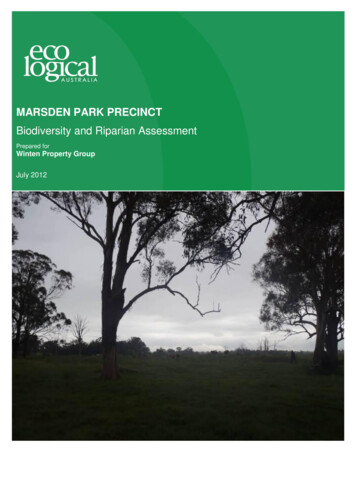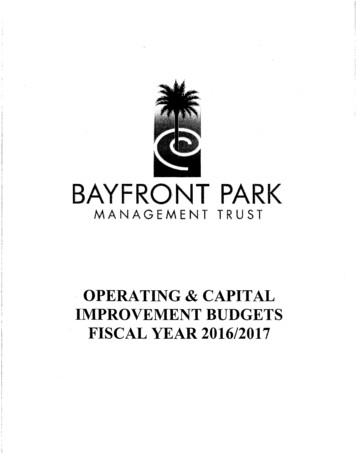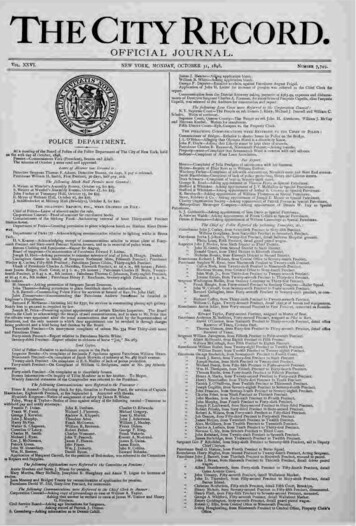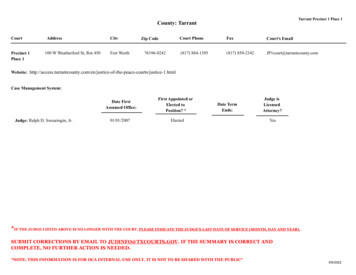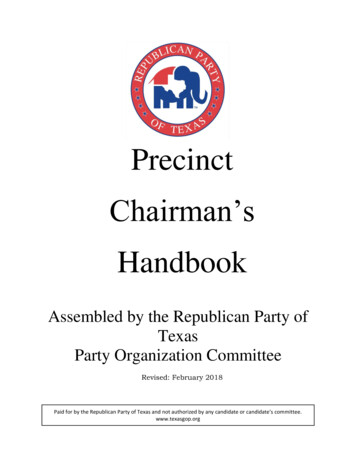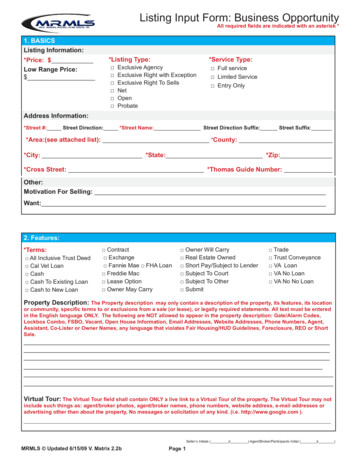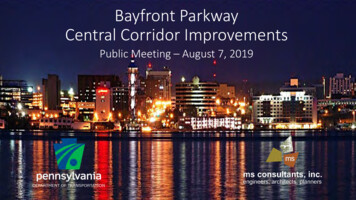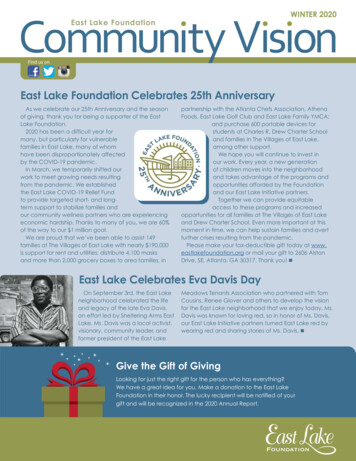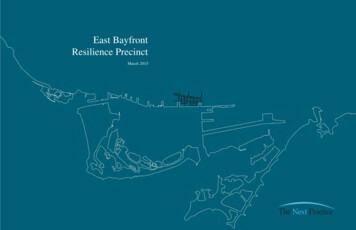
Transcription
East BayfrontResilience PrecinctMarch 201510
East BayfrontResilience PrecinctPrepared byThe Next Practice Ltd.Jeb BrugmannMaria Gómez-Llabrés11
Table of ContentsSection 1Introduction:The case for resilience planning3The case for resilience planningAbout this documentSection 2East Bayfront Precinct:Adding resilience to the plan 5Section 3Local Area Risk Analysis:Preparing a comprehensive risk profile9Risk to PerformanceRisk to FunctionBuisiness and Market RisksRisk to AdaptabilityRisks to Re-InvestmentSection 4De-risking the Performance Promise of theNew East Bayfront11A Truly Mixed Use CommunitySustainabilityAffordabilityQuality of ServicesSection 5 Mapping East Bayfront ResilienceChallenges 13Section 6Resilience Planning: The processSection 7Conclusion: Planning for North America’sfirst ‘Resilience Zone’ 23212
Section 1ent StStParliamJarvisYongeSt‘Resilience’ has emerged as a new area of planning interest,specifically within the context of climate change andrelated extreme weather events. As a new area of interest,resilience planning frameworks are still in the early stages ofdevelopment. Even the definition of resilience in the urbancontext is still evolving.York StBathrust StThe case for resilience planningSpadina AveIntroduction:The case for resilienceplanningEast BayfrontWest Don LandsCentral WaterfrontPort Lands 2015 The Next Practice Ltd.The framework presented in this document has been designedby The Next Practice (TNP) with two distinct objectives inmind. The first objective is to approach resilience in a way thatresults in the creation of additional value in urban places andassets—and that does not just impose new costs. Much ashas been demonstrated by the emergence of green buildingas a new area of market-based performance, the objective isto make resilience an investment worthy priority for the publicand private sectors alike.Resilience is of course already an area of concern in boththe public and private sectors. Costly catastrophes suchas Hurricane Katrina in New Orleans and Hurricane Sandyin New York/New Jersey have been catalysts for concernin the arenas of property management, utilities, insurance,community development, infrastructure, habitat restoration,as well as urban planning.However, current approaches to resilience planning thatare related strictly to climate adaptation have not triggeredproactive investments to prevent such losses. Extensivestudy was made of exposures to extreme weather events inNew Orleans and New York prior to the Katrina and SandyLower Don LandsEast Bayfront Resilience PrecinctMap 1 : Map of Toronto Waterfrontcatastrophes. In neither instance did this planning, nor anyother property market signals, instigate significant measuresto prevent hundreds of fatalities and tens of billions in propertyand business losses, including the complete failure of entirecity districts.These and other disruptive events, such as major floods (e.g.,Calgary and Toronto), fires (e.g., San Diego, Sydney), powerfailures (Northeast Canada and USA 2003), and heat waves(France 2003) have highlighted the need to create marketincentives for more proactive risk management in urban3
areas1. The recent focus on climate change risk is buildingcapacity in local governments for improved risk assessment.But this paper suggests that addressing climate risks shouldnot be an end in itself. As the East Bayfront case indicates,climate and other catastrophic risk challenges are criticalcatalysts for fuller introduction of Enterprise Risk Managementinto urban planning, local economic development planning,and development project management. 2015 The Next Practice Ltd.As the range of urban risk exposures increases, the secondobjective of the presented resilience planning framework isto ensure that ‘resilience’—in other words, the de-risking ofurban places—is applied comprehensively and not only as aspecial topic related to catastrophic risks.Over the last decades, other costly burdens have alsobeen imposed on communities, local governments, and thebusiness sector by diverse urban risks, often concentratedin specific districts or areas. These include public healthrisks, property market risks of both a systemic and regionalnature, the loss of major employers, and aging infrastructure.Added to this is the further, endemic risk that developmentprojects do not deliver their promised performance benefitsand economic value. The engagement of stakeholders inurban risk management will be more effective if focused onthe full array of exposures confronting any particular city area,including the area’s performance risks.For this reason, the following approach proposes the inclusionof resilience elements in urban plans at the precinct or districtscale. The resilience element of a plan would address therisk profiles of precincts and their resident and businesscommunities comprehensively. These comprehensive profileswould be used to identify and prioritize measures to de-riskplaces and to manage remaining exposures and vulnerabilities.The ultimate objective is to ensure that the resulting ‘resiliencezones’ can more predictably deliver promised benefits to usersand anticipated returns to investors, relative to alternativelocations. If well communicated, such a resilience zone shouldsecure additional competitive advantage.About this documentResilience planning takes place within the context ofsignificant legacy risk management practices. Environmentalassessments, development permitting, building codes,licensing regimes, emergency services and public healthstandards, financial due diligence etc. have each beendesigned to address historically prioritized risks. However,when (re)developing unique sites, to serve unique functions,with unique performance ambitions, these redevelopedplaces assume unique risks that may not be fully taken intoconsideration by existing risk management standards andprocedures. Furthermore, the fractured nature of the urbandevelopment process often encourages the passing on ofunmanaged risks to the public sector and downstream users,rather than collaboration to reduce them. This was amplyillustrated by the 2007-2008 financial and property marketcrisis in the United States and Europe.The collaborative pursuit of preventative measures occurswhen stakeholders believe that tangible benefits will accrueto them, in particular because the market will recognizeresilience as a form of competitive performance. The followingframework has been developed to both incent and support thedevelopment of resilience as a distinct performance benefit atprecinct, neighborhood, and district scales.Extensive planning studies were commissioned by WaterfrontToronto and the City of Toronto for the East Bayfront precinct,reflecting high standards.Related to these extensiverisk identification and analyses have been undertaken.However, when considering the resilience of a precinct, morecomprehensive and extensive risk analysis is required than isthe convention for projects of this kind.This document explores the use of resilience planning as anelement in district, precinct and other local area plans. Thedescribed approach is illustrated by using Toronto’s EastBayfront precinct plan as a case example. The East Bayfrontplan and regeneration project is referenced for indicativepurposes only.This document does not present recommendations about theresilience priorities and requirements for the East Bayfrontprecinct, as these would need to be based upon risk analysesand stakeholder engagement activities that have not beencommissioned. For the sake of clarity, the document also isnot associated with the East Bayfront planning and designwork of Urban Strategies Inc., Koetter, Kim & Associates, orPhillips, Farevaag, Smallenberg. It is in no way derivative oftheir works.1See Brugmann, J. 2013. Building Resilience Cities: From risk assesment toredevelopment. Boston: Ceres, The Next Practice, University of CambridgeInstitute for Sustainability Leadership4
Section 2East Bayfront Precinct:Adding resilienceto the planAs an extension of Toronto’s important media industry cluster,home to prominent institutions, and as a new mixed incomeresidential community and destination recreation area, EastBayfront can be the North American leader in a new type ofurban performance: resilience. The East Bayfront precinctcan offer built-in assurance to investors, owners, tenants,residents, and users that its unique functions, attractions,benefits, and valuations will be secured against major risksfor decades to come.Film & MediaOther Waterfront IndustryMap 2 : Film & Media Industry clusterTremendous resources have been and will be invested todesign and deliver a new precinct with best-of-class performance. The addition of a resilience element to the East Bayfront vision and plan would ensure that its promised performance as a location of choice would be reliably delivered fordecades to come. 2015 The Next Practice Ltd.Flood depths less than 1.0 mLocated on a waterfront in a flood plain area along a densemulti-modal transportation corridor, during a time of substantial adjacent redevelopment projects, and of market, demographic, and climate changes, the mixed use precinct will beara unique risk profile. The preparation of an East Bayfront resilience plan element would support delivery of the precinct’spromised open space amenities, affordability, and green andtransit-oriented performance and at the same time make it aflagship demonstration of resilient urban development of international significance.Floods depths greater than 1.0 mMap 3 : Flood Plain Area (source: Toronto and Region Conservation Authority for the Living City)HighwayTrain RailsSubway & Street CarCyclingPassenger FerryAir TravelThe following pages offer a conceptual outline of the issuesand process used for preparing such a planning element orResilience Plan.Map 4 : The East Bayfront before redevelopment: within a multi modal transportation corridor5
Map 5 : East Bayfront Existant (source: Google Maps 2015)6
LAKESSWAYEASTQUEEN’S QUAY EASTRedpathSugarFactoryJarvis law’sBONNY CASTLE STSTBLVDURNERICHALOWEXPRESHORERDSON STR JARVIS STINER EPARLIAMENTSTGARDPOTENTIAL FUTUREEXTENSION OF QUEEN’S QUAYParliamentStreet SlipGeorge BrownCollegeSHERBOURNEPARKSugarBeachTORONTO INNER HARBORMap 6 : East Bayfront Master Plan (source: Waterfront Toronto)7
LAKESXPRESSWAYBLVDEASTJarvis StreetSlipCorusEntertaintmentGeorge BrownCollegeSTSMALLURNESHERBOLOWERQUEEN’S QUAY EASTBONNY CASTLE STSTRDSON STHORERICHALOWER JARVIS STINER EPARLIAMENTSTGARDPOTENTIAL FUTUREEXTENSION OF QUEEN’S QUAYParliamentStreet SlipTORONTO INNER HARBORMap 7 : East Bayfront: Land Use (source: MMM Update - March 2013)Private LandPublic Land8
Section 3Local Area Risk Analysis:Preparing a comprehensiverisk profileThe Next Practice’s (TNP) Local Area Risk Analysis (LARM)framework supports stakeholders to identify the wide range ofrisk exposures associated with a planned area and, importantly,with the delivery and maintenance of the area’s performancepromises to investors, service providers, residents, tenantsand visitors.The LARM framework applies concepts of Enterprise RiskManagement (ERM) to places. ERM is now widely used as acore practice in corporate management, because it focusesrisk management on the achievement of the organization’sbusiness objectives within an environment of complex andmanifold risks. Similarly, LARM approaches district-scale riskmanagement as a practice not only to avoid risks, but alsoto reduce impediments to the achievement of local economicdevelopment, policy and place-making objectives. The aimis to use risk assessment and risk management planning toreinforce the guarantee of a premium location for residentsand/or businesses relative to other location choices. 2015 The Next Practice Ltd.Figure 1: An overview of the Local Area Risk Management approach(source: Ceres/The Next Practice/University of Cambridge, 2013)rarely adequate. In fact, standards may themselves be a riskto promised performance.The first step in LARM analysis is preparing an inventoryof risks that will be faced by the current and future owners,service providers, businesses, households, and visitors/customers. Risks are identified and explored in five areas:RISKS to PERFORMANCEThese are risks to the key performance promises of theprecinct as defined in the precinct plan. Risks to performanceare primarily managed through measures associated withdesign, staging/delivery, and ongoing property and placemanagement, including both asset operations management,leasing, and place-making or ‘curation’ of the promised resident,business and activities mix. Examples of performance risksare provided in the next section.RISKS to FUNCTIONHistorically, risk management in development planninghas concentrated, sometimes exclusively, on site risk (e.g.,flooding, environmental impact), risks and liabilities associatedwith legacy uses (e.g., contamination, rail corridor), and on thefinancial risks of the immediate investment project. Longerterm risks to the fulfillment of promised performance are nottypically given substantial attention in planning and design. Agreat deal of what is articulated in visions, strategies, and plansmay not be supported by a risk management strategy. Theunderlying assumption is that such performance risks havebeen implicitly addressed in zoning, building and licensingstandards. However, especially when projects incorporaterelatively new forms of performance, the legacy standards areThese are risks to the basic function of the precinct includingdisruption of utilities and services, risks to efficient accessand egress, and emergency events. Risks to function areprimarily managed through design, utilities upgrades, theestablishment of redundancies, and emergency planningand services provision that are tailored to a precinct’s uniquerisk exposures. Maintaining the capacity for safe failure is aminimum objective. Examples of possible risks to function inthe East Bayfront precinct might be: Flood risk Power outages Inadequate infrastructure capacity9
BUSINESS and MARKET RISKSRISKS to ADAPTABILITYThese risks arise from disruptive changes in markets thatundermine anticipated returns on property investments aswell as the industries and businesses clustered in a precinct.Business and market risks may be managed by diversifyingindividual business exposures through collective investmentsand the pooling of risks, including through insurance andother financial instruments. Examples of possible business/market risks for retailers and for media-related companies inthe East Bayfront precinct might include:These risks arise from inflexible design, technology choices,capitalization, contracts, and regulation of activities, whichprevents the adaptation of physical assets and space, and ofprecinct activities and business models to changing markets,technologies, social trends, and the natural environment.Examples of possible risks to adaptability in the East Bayfrontprecinct might be: Risks of commercial unit vacancies (including propertytax risk) Currency risk exposure for companies dependent uponexport markets or foreign inputs Cost inflation risks Equipment and power supply risks Risks associated with technology change, includingnew on-line business models which enable the outsourcingof design and production, on-line retail, on-line distanceeducation Design that creates inflexible, but underutilized spacesthat cannot easily be converted to fuller uses (e.g., anunactivated plaza between two privately owned commercialbuildings dedicated to underground parking access) Dependencies on legacy infrastructure and grid networks Insufficient land allocation for new utilities or infrastructure Fixed design of residential units for one demographicRISKS to RE-INVESTMENTThese risks are risks to capital access or to the attractionof capital for investment in new technology, infrastructure,building improvements, or redevelopment, including poormanagement of financial exposures of anchor businesses,and of local stakeholder relations. Risks to re-investment areprimarily managed through the creation of pooled financingmechanisms, such as special assessments, or district utilitiesor redevelopment entities with access to capital markets.Examples of possible risks to re-investment in the EastBayfront precinct could be: Risks of maintenance and retrofit re-investments inlarge residential buildings, in particular by condominiumassociations in the instance that widely used building materials(e.g., glass ‘skins’) are not durable Risks of poor precinct-scale management, governanceand investment promotion mechanisms Risks of underinsurance (e.g., in the instance ofcatastrophic events) 2015 The Next Practice Ltd. Labor supply/talent risks Malicious computer risks, e.g., hackers, viruses etc10
Section 4De-risking thePerformance Promise of theNew East BayfrontMost area and redevelopment plans give considerableimportance to unique performance features, not only toimplement policy but to attract investment, sales, tenancies,and political/public support. However, it has becomecommonplace that delivered projects underperform relativeto their marketed, ambitious promises. Conversely, projectsthat fulfill or exceed their performance promises can secureinternational reputational value that provides immediate andlongstanding economic returns to places and their assets aswell as to the city and to the project’s planners, designers, anddevelopers.The East Bayfront precinct plan outlines four particular areasof distinctive performance, i.e., the precinct’s ‘performancepromise.’ Among other risk areas, a resilience plan element forEast Bayfront would address these key aspects of promisedcommunity character: A Truly Mixed Use Community Sustainability Affordability 2015 The Next Practice Ltd. Quality ServicesThis section identifies examples of risks specifically associatedwith these performance ambitions, which would be furtherevaluated through a resilience planning exercise.A Truly Mixed Use CommunityMixed use communities bear risks specifically associatedwith each of the major uses (e.g., business, recreation,entertainment, family residence) as well as with the conflictsand incompatibilities that can arise when different user groupspursue their objectives in the same densely used location.East Bayfront risk exposures that may be associated with thein situ mix of uses could include: Personal safety risks associated with the dense mix ofautomobile, public transit, industrial rail, pedestrian, cycling,and rollerblading modes of mobility along one busy andnarrow corridor Noise disturbance associated with residence in an areaof heavy weekend visitor/tourism use Conflicts over uses of public space and facilities as bothneighborhood amenities, employee and student amenities,and city-wide recreation amenitiesSustainabilityThe East Bayfront precinct plan places a strong emphasison both social and environmental sustainability performance.Risk exposures may include:: Delay or unstable political and financial support for thecostly Lower Don flood control and naturalization projects Delayed build-out of public transit services Increased traffic congestion and idling and associatedair quality problems, in particular in identifiable intersections Risk to residential affordability (see below) Risks to accessibility by families of diverse backgrounds(and not only younger singles and couples at the early stagesof their careers)11
Increased storm water runoff, particularly of highphosphorous and chloride levelsAs indicated in the East Bayfront plan, the location of a mixeduse precinct in such a central city location is itself a SmartGrowth measure. However, achieving the precinct’s promisedperformance as a “national and global model for sustainability”will be a continuous challenge in a world where regenerationprojects are every year reaching new, unprecedented levelsof eco-district performance in terms of renewable energy,grey water re-use and minimal storm water run-off, urbannutrient cycling and food production, ‘wellness’ design anddistrict standards. A Resilience Plan for such an ambitionwill need to establish mechanisms for continuous review andimprovement of sustainability performance.Affordability 2015 The Next Practice Ltd.The current precinct plan already includes measures to reduceand mitigate risks associated with housing affordability. Theseaffordability measures are also directly linked to the precinct’sambition as a diverse, mixed-income residential community.Among these is the establishment of a special institutionalmechanism, the Waterfront Housing Trust. Other measuresinclude: Providing family services at the earliest possibleopportunity, including excellent day care, community andschool facilities Encouraging the creation of larger housing units andgiving priority to families with children in the allocation ofthose units Seeking community support and sponsorship for seniorhousing, long-term care facilities, and housing for downtownworkers Providing a mix of affordable and market housing sitesacross the waterfrontAmong the near-term risks to the success of these measuresis the securing of program funding to achieve the 20% targetfor affordable rental housing. Another risk may be the ability tosecure a school and community centre for the precinct in lightof extensive pressure on the school board to close schools,liquidate properties, and address a large city-wide capitalmaintenance backlog. Special training, staffing and protocols for suchservices, so that they are most responsive to the uniquefeatures and uses of the precinct in different seasons Services and facilities capital and operating funding inlight of budgetary constraints The adaptability of facilities to respond to demographicchanges or unexpected demographic patterns in the precinctMost of the measures to establish affordability focus onthe through delivery and early establishment stages of theprecinct. However, the risks to affordability extend well beyondthese early stages and are likely to increase with the successof the precinct, as delivered according to plan. Measures areneeded to maintain affordability once units are re-sold on themarket. This specifically applies to the 5% mix of ‘low endof market’ market housing, and objectives to provide a livework precinct for lower paid service employees. Affordabilitymaintenance in the context of rising downtown prices mayrequire maintaining part of the housing stock under co-op,shared equity, or life-lease schemes, as well as measuresto contain monthly maintenance fees and utilities charges,provide access to affordable food and other retail options, andto reduce commuting requirements and costs.Quality ServicesThe precinct plan includes a full complement of emergency,educational, and recreational services and facilities. AResilience Plan element would consider issues such as:12
Section 5Mapping East BayfrontResilience ChallengesThe initial, comprehensive identification and prioritizationof risks at early stages of the planning effort enables theincorporation of risk reduction measures from the project’soutset. These risks can be mapped to highlight particularareas of current and potential risk concentration, meritingtailored measures.standards and planning procedures in North America) andthose that are not consistently evaluated in standard NorthAmerican practice. The first sectional map (Map 10) illustratesthe combination of all of these types of possible risk in onelocation, emphasizing the need for a specific Local Area RiskManagement approach for an area of that nature.The following maps provide an indicative illustration of therange and spatial concentration of risks in the planned EastBayfront project and precinct. The maps are indicative only.The maps do not represent a list of prioritized risks based onlikely incidence and impact. 2015 The Next Practice Ltd.The plan maps illustrates types of risks associated with theEast Bayfront location and its planned uses and elements,including its stated performance promises. The maps provideexamples of the spatial location of these exposures (seeindicative Map 8). A fuller risk mapping exercise, involvingall the key stakeholders, would produce a clear indicationof the typical clusters and concentrations of the prioritizedrisk exposures in the precinct (see Maps 8 and 9). Such anidentification of high risk locations would trigger discussions ofpossible risk management measures and/or plan adjustments.The sectional maps (Maps 10-13) are indicative of the possiblespatial concentration of risks in a risk hotspot area, i.e., amajor intersection on the multi-modal Queens Quay Boulevardcorridor. Four sectional maps are presented to differentiatethose risks that are typically considered in the preparationof a precinct plan (according to existing project assessment13
Map 8 : East Bayfront Precinct: Map of Local Area Risks (indicative)SYMBOLS LEGENDCurrent Industrial UsesDeveloped Buildings of the Precinct PlanProposed Build-out as per Precinct PlanUnocupied areasVacant ground floor retailCommunity Facilities (school, recreation)Flood area in arrow sideRISK ICONS LEGENDPERFORMANCEAir quality issuesFlood riskDelays in project delivery, staging problemsGrid stress / Power outagesNuisanceHigh windsRisks of non-activated ‘no man’s land’ spacesEmergency servicesPotential loss of affordability for priority demographicsExtreme heat eventsAccident prone areasInadequate infrastructure capacityTraffic congestion on main corridorsRainfallTraffic jamPoor air qualityRISKS TO FUNCTIONArchaeological / Heritage risksImpacts on aquatic environmentADAPTABILITY TO CHANGEHabitat / Species risksInflexible spatial planFood safety risksOld legacy infrastructureLarge single purpose buildingsBUSSINESS / MARKET RISKSDesign for residential units for one demographic 2015 The Next Practice Ltd.Risk of commercial unit vacanciesCurrency risk exposure for companies dependent uponexport markets or foreign inputsRE - INVESTMENTProject financial risksNondurable building materialsMalicious computer risksPoor precinct-scale managementHazardous material risksChemical contamination14
Rush hoursGeorge BrownCollegePublic facilities ctoryFlood infrastructureWeekends / nights 2015 The Next Practice Ltd.Potential delay in flood control infrastructureAuto exhaustAdjacent to heavy trafficRail trails areaHousing for senior citizensTraffic lightsSmall format retailRush hoursSmall format retailElevated expresswayDelayed transit extensionMedia Industry risksRush hoursCongested intersectionCombined sewage and storm waterLoblaw’s15
Map 9 : East Bayfront Precinct: Risk hotspots and clusters (indicative)GARDBLVDEASTSTSMALLSHERBLOWERBONNY CASTLE STSTHORESWAYOURNERDSON STLAKESXPRESRICHALOWER JARVIS STINER EPARLIAMENTSTC2. SENIORSQUEEN’S QUAY EASTB1. INTERSECTIONHOTSPOTsee section maps 10 - 13 2015 The Next Practice Ltd.C1. MEDIA INDUSTRYA. Area-wide Risk Management PrioritiesThese are risks to the performance of the entire precinct, relative to itsplan and for all owners, residents, tenants, and users.A1. Dead zonesB. Risk Hotspot LocationsThese are concentrations of diverse and potentially cascading risks withinspecific places within the precinct. Risk hotspots are places that will likely bemost challenged in terms of performance, management, and risk of failure.C. User Group Risk ClustersThese are the unique mixes of risk exposures specific to particularowners, tenants, residents, or users.A2. Delivery delayB1. The intersectionsC2. SeniorsC1. Media Industry16
Map 10 : Sectional rendering of a risk ‘hotspot’ area, Queens Quay corridor, East Bayfront, TorontoThis map illustrates the possible concentration of differenttypes of risk at a potential ‘risk hotspot’ area in the plannedEast Bayfront precinct.CLIMATE CHANGE RISKS 2015 The Next Practice Ltd.OTHER LOCALAREA RISKSESTABLISHED RISKMANAGEMENT AREAS17
Map 11 : Established risk management areas, Queens Quay corridor East Bayfront, Toronto (indicative).These are risks that are already factored in existing planningand development procedures, including environmental impactassessment.Exposure to work noiseFood safety, fire hazardBirds collisionsFreight train 2015 The Next Practice Ltd.Emergency services accessStorm water capacityWater supplyContaminated soilsESTABLISHED RISKMANAGEMENT AREASSewerage capacity18
Local governments have placed increasing focus on a newrange of risk exposures associated with climate change. Thismap illustrates how climate-specific exposures contribute tothe risk profile of a hotspot area in the precinct plan. 2015 The Next Practice Ltd.CLIMATE CHANGE RISKSExtreme storm / wind eventsSmog eventsGrid stressMap 12 : Climate change risks, Queens Quay corridor East Bayfront, Toronto (indicative).19
Map 13 : Other local area risks, Queens Quay corridor East Bayfront, Toronto (indicative).In addition to the established risk management areas andrecently identified (although not yet predictable) climatechange exposures, each local area is exposed to a widerrange of risks unique to its location, use, users, and promisedperformance.Staging problemsMedia Industry risksMonofunctional buildingHousing for senior citizensCommercial vacanciesOTHER LOCALAREA RISKSTraffic lightsWeekends / nights 2015 The Next Practice Ltd.Delayed transit extensionCombined sewage and storm waterPotential delay in flood control infrastructureRush hours20
Section 6Resilience Planning:The processThe preparation and mapping of a comprehensive risk profiledoes not typically provide project proponents and plannerswith sufficient support to prepare a risk management strategyfor the area, including risk r
Bayfront can be the North American leader in a new type of urban performance: resilience. The East Bayfront precinct can offer built-in assurance to investors, owners, tenants, residents, and users that its unique functions, attractions, benefits, and valuations will be secured against major risks for decades to come.
